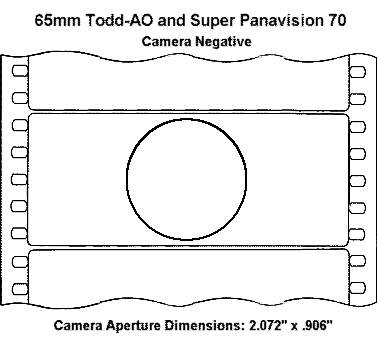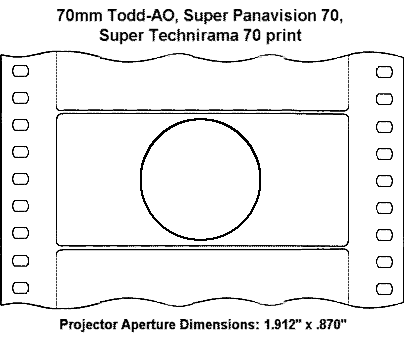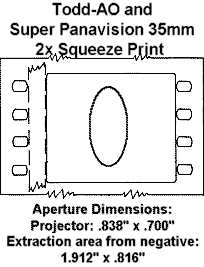Year of Introduction: 1955
NEGATIVE SPECS:
Film Gauge: 65mm
Direction of travel: Vertical - five perforations - 24 fps / 30fps for first 2 features
Camera Optics: Spherical
Aperture Dimensions: 2.072" x .906"
Max Aspect Ratio: 2.21:1
PRINT SPECS: 70mm Roadshow Print
Film Gauge: 70mm
Direction of travel: Vertical - five perforations - 24 fps / 30 fps for first two features
Projector Optics: Spherical
Aperture Dimensions: 1.912" x .870" nominal
Max Aspect Ratio: 2.21:1
Sound Format: Magnetic Six Track Stereo - L, LC, C, RC, R stage channels and mono surround channel - (Perspecta directional tones used in surround channel in one feature.)
Screen Design: 120 degree seamless curved screen. This feature was virtually abandoned by 1958 in favor of flat screens that were compatible with showings of other film formats.
These print specifications are considered standard for the majority of 70mm prints, regardless of the image source.PRINT SPECS: 35mm Anamorphic Reduction Print
Film Gauge: 35mm
Direction of travel: Vertical - four perforations - 24 fps
Projector Optics: 2x Anamorphic squeeze
Aperture Dimensions: .839" x .700" nominal
Max Aspect Ratio: 2.35:1 (with squeeze)
Sound Format: "Magoptical" Four Track Stereo as per CinemaScope, plus half width mono optical - CS perforations
Alt Sound Format: Optical monophonic - Standard perforations
35mm reduction prints are taken from the center of the negative using an area of 1.912" x .816".
Unique 35mm prints were made for certain showings of Around The World In 80 Days. See text for details.


